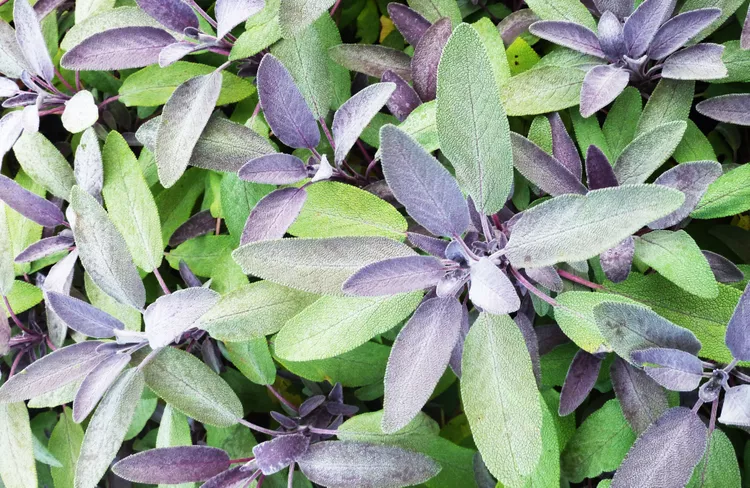If you’re growing culinary sage, chances are you want to use it in the kitchen. To do so, you’ll have to harvest it first, but snipping pieces off a plant you’ve nurtured can be intimidating. Here's how to harvest sage including a few helpful tips to guide you.
Selecting Culinary Sage
While many members of the genus Salvia are popular in the garden, it’s usually the common or garden sage (Salvia officinalis) and sometimes pineapple sage (Salvia elegans) that are used in the kitchen. Garden sage is a staple herb for many fall dishes, such as roast turkey with citrus and sage, pumpkin-sage white cheddar biscuits, or pumpkin, barley, and sage soup.
Many sage plants, like Russian sage, are intended to be ornamental. The harvesting methods here work equally well for all types of culinary sage.
Harvesting Sage Leaves
Harvesting sage can be as simple as trimming a few leaves to chop and toss in a soup. In autumn, larger harvests can be preserved to bring the flavor of the herb garden to dishes all winter. When harvesting sage, use scissors–or a sharp thumbnail and forefinger–and take one leaf at a time. Snipping directly into a small basket makes gathering larger amounts easy. When harvesting an entire stem, cut it off just above a node.
Young leaves can be left on the stem, even when used in the kitchen. However, older leaves benefit from removing the stem, which can start to get tough. Harvest only a third or less of the plant at a time to keep sage healthy. The exception is if you’re doing the last harvest of autumn (trimming the plant back for winter) or plan on replacing the plant due to age.
Timing the Harvest
Since you’re harvesting only the leaves, not a fruit like an apple or a tomato, there is no specific window when sage is ready or ripe. The time to harvest is when the leaves are full-sized and healthy. Young plants should be allowed to grow a bit before harvesting. Older plants can and should be harvested frequently to keep them producing new, soft, healthy vegetation.
Like many herbs, sage is best harvested in the morning after the dew has dried for peak flavor. The oils that give sage its wonderful aroma and flavor are at their highest in the late morning.
Sage can be harvested whenever there are enough leaves on the plant. Fresh new growth is the tastiest and most aromatic, and frequent harvests keep the plant in vegetative mode and delay or prevent flowering. While the flowers of culinary sage types are lovely, they can soften or dilute the flavor of the leaves. If you use sage often, which you might after experiencing fresh garden-grown herbs, keep two or three sage plants in a container and rotate your harvests.
Preserving Harvested Sage
While a few leaves nipped here and there are easy to use, larger autumn harvests or bountiful summer clippings from many plants can be preserved for later use. Not only is this one of the best-smelling tasks you've ever done, it's easy. While sage is usually dried, it can also be frozen. Whichever method you choose, store the herbs in an airtight container out of the light for the best flavor and longest life.
Drying Sage
Drying sage is easy no matter which method you choose. Sage is properly dried when the leaves are brittle and easy to crumble. A few methods to get you started include:
- Using a food dehydrator: Lay the sage leaves on the dehydrator tray, and it does the rest. They’re usually dry in 8-12 hours.
- Hang-drying: This method adds to the decor. Harvest the sage with the stems still attached, like cut flowers. Tie them in small bundles (large bundles don’t dry well) with a piece of twine and hang them upside down with a string in a dry, dark, airy spot. They’ll be dry in a week to 10 days.
- In the oven: Lay the herbs flat in a single layer on a wire rack or a cookie sheet lined with parchment paper, and set the oven to 180℉. If it has a fan, turn that on as well. It takes about 2-4 hours.
Don’t hang herbs to dry near your stove. The rising grease-laden air will coat the herbs, creating a sticky mess.
Freezing Sage
Fresh herbs—including sage—can be frozen. It’s super simple and yields amazing results. Rinse the herbs and pat them dry. Lay them in a thin layer on a baking sheet lined with parchment paper (so they don’t freeze to the tray) and pop them in the freezer for an hour. Pull them out, put them in an airtight bag, and squeeze all the air out gently with a rolling pin. You’ll have a flat, easy-to-store bag of sage ready for later use. It keeps well in the freezer for a couple of months.




















